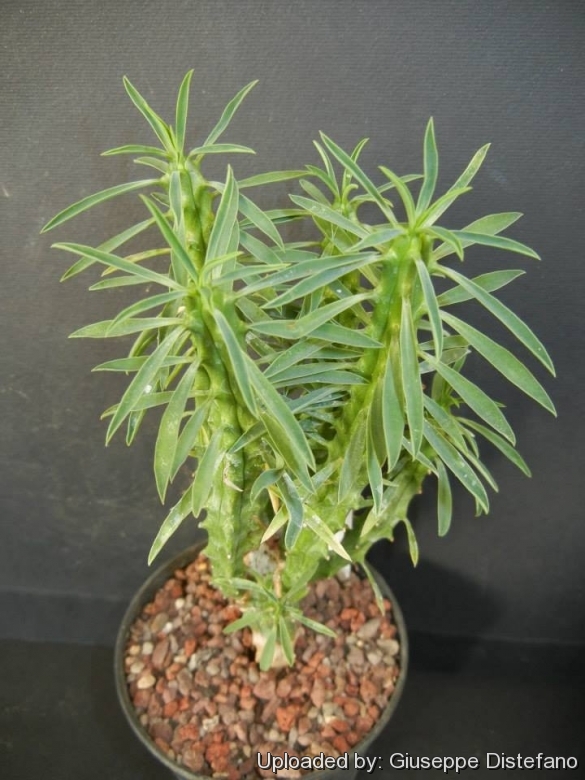




Your support is critical to our success.

Origin and Habitat: Republic of South Africa, Western Cape, Namaqualand (Prince Albert, Sand River Mountains, Van Rhynsdorp, Gift Berg, Clanwilliam, Lange Valley, Olifants River Valley, Kanakas Berg, Wupperthal)
Altitude: 50 - 1035 meters above sea level.
Habitat: It grows in a mossy-lichen habitat in steep slopes.
Synonyms:
- Euphorbia loricata Lamarck
Euphorbia loricata Lamarck
Encycl. (Lamarck) 2: 416 1788
Synonymy: 4
- Euphorbia loricata Lamarck
- Euphorbia armata Thunb.
- Euphorbia hystrix Jacq.
- Treisia hystrix (Jacq.) Haw.
RUSSIAN (Русский): Молочай панцирный
Description: Euphorbia loricataSN|27166]]SN|27166]] is a slender leafy succulent with long, sharp thorns. In summer it is, of course, leafless.
Habit: Perennial-succulent shrub 30-100 cm high, branching from the base and
above.
Branches: Erect, 8-12 mm in diameter, fleshy, thick, glabrous, cylindric, with shallow tubercles in spiral series, and numerous persistent rigid peduncles.
Leaves: Well developed, clustered at branch-tips, linear or linear-lanceolate, obtuse and minutely apiculate at the apex, 25-75 mm long, 3-6 mm broad, tapering to the narrow sessile base, glabrous on both sides.
Spines (modified peduncles): Numerous, rigid, ascending, solitary, 3-4 mm long, grey or brown.
Flowers (Cythia): Solitary on peduncles 1.2 - 5 cm long, when young bearing three broadly ovate or orbicular-obovate bracts 5-8 mm long and 5 mm broad surrounding one Cythium at the apex. Cythium sessile within the bracts, 6 mm in diameter, cup-shaped, glabrous, with 5 oblong nectar-glands 2-3 mm in their greater diameter green and 5 subquadrate fringed lobes. Styles united into a column about 1 mm long, with spreading bifid arms 1,5 mm long.
Fruits (Capsules): Globose, erect sub-sessile on a pedicel about as long as the cyathium, 7 mm in diameter, with 3 very slight furrows, not at all lobed, glabrous.
Seeds: Ellipsoid-oblong or ovoid, 3 mm, rugulose, greyish-brown.
Bibliography: Major references and further lectures
1) James Cullen, Sabina G. Knees, H. Suzanne Cubey “The European Garden Flora Flowering Plants: A Manual for the Identification of Plants Cultivated in Europe, Both Out-of-Doors and Under Glass” Cambridge University Press, 11/ago/2011
2) Urs Eggli “Illustrated Handbook of Succulent Plants: Dicotyledons” Springer, 2002
3) Hermann Jacobsen “Abromeitiella to Euphorbia” Blandford Press, 1960
4) Doreen Court “Succulent Flora of Southern Africa” CRC Press, 01/giu/2000
5) Alain Campbell White, Robert Allen Dyer, Boyd L. Sloane “The succelent Euphorbisae (southern Africa)” Abbey garden press, 1941
6) Werner Rauh “Cultivation and Description of Selected Succulent Plants Other Than Cacti” Smithsonian Institution Press 1984
7) Gibbs Russell, G. E., W. G. Welman, E. Reitief, K. L. Immelman, G. Germishuizen, B. J. Pienaar, M. v. Wyk & A. Nicholas. 1987. “List of species of southern African plants.” Mem. Bot. Surv. S. Africa 2(1–2): 1–152(pt. 1), 1–270(pt. 2).
8) N. E. Brown, J. Hutchinson and D. Prain. “Flora Capensis”, Vol 5 Part 2, page 216 1925
Cultivation and Propagation: Euphorbia loricataSN|27166]]SN|27166]] is an easy species to grow that is suited for any well drained soil in full sun. But young plant are happy growing indoors, where they can easily reach the ceiling. Give the plant an airy growing medium which mainly consists of non organic material such us clay, pumice, lava grit, and only a little peat or leaf-mould. Water regularly during the active growing season from March to September. No water should ever be allowed to stand around the roots. Keep almost completely dry in winter. It is a moderately fast grower, and will quickly become large landscape masterpieces in just 3-5 years. Only downside is from strong winds, the columns often smash into each other, causing permanent scarring... best to plant in such a location where winds are not a big issue. If plant becomes very red, this is a sign that the roots have not developed properly. It is a relatively fast growing and long lived plant and once established, it will be content in its position and with its soil for years. It can tolerate moderate shade, and a plant that has been growing in shade should be slowly hardened off before placing it in full sun as the plant will be severely scorched if moved too suddenly from shade into sun. Like quite small pots, repott in very later winter, early spring. Can be pruned for shape and branching.
Hardiness: Frost tender, frost free zones only.
Plant Pests: Prone to mealy bugs and rarely scale.
Propagation: It is easy to propagate by cuttings in late spring to summer, just take a cutting of the plant let it dry for 1 or 2 weeks and stuff it in the ground (preferably dry, loose, extremely well draining soil).
Warning: All Euphorbias contain a white sap that can be irritating to eyes and mucous membranes. If contact is made with this white sap, take care to not touch face or eyes before washing hands with soap and water.
| Your Actions | |
|---|---|
| Back to Euphorbia index | |
| Back to Euphorbiaceae index | |
 |
Back to Succulents Encyclopedia index |
Privacy stantement - Terms and conditions - How to cite - About us - Feedback - Donate



